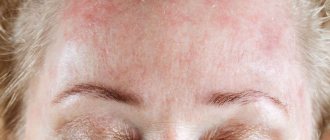Published: 06/28/2021 13:30:00 Updated: 06/28/2021
Amenorrhea is a condition in which women of childbearing age do not have menstrual periods for three months with a previously regular cycle and six months or more with an irregular cycle. During pregnancy and breastfeeding, it is considered a normal manifestation of physiological changes in the reproductive system. In other cases, the violation indicates a pathological process of the reproductive system or hormonal imbalance. These deviations are a serious pathology and are closely related to the development of infertility and many other diseases.
Among women aged 16–45 years, the prevalence of pathology varies from 5 to 13%. Moreover, in the vast majority of cases, the condition develops in previously menstruating patients, and only in 25% does primary amenorrhea occur - delayed menarche (first menstruation) in girls.
Types of amenorrhea: norm and pathology
- Physiological
. Typical for women during pregnancy and breastfeeding, it is not a pathology. After cessation of lactation, the menstrual cycle returns to normal. - False
. A form of amenorrhea in which no endocrine, hormonal or gynecological disorders are observed, but menstruation is absent for 3 months or more. - Primary
. This diagnosis is given to girls if they have not started menstruating before the age of 16. - Secondary
. A pathological form of amenorrhea, which occurs due to exposure to stress, the development of endocrine and gynecological diseases. - Uterine
. A pathological form of amenorrhea resulting from destruction of the endometrium.
Features of the method
For women who follow the recommendations and meet the criteria (listed below), LAM is a very effective method of contraception:
- Breastfeeding should be the only (or almost the only) source of nutrition for the baby. Feeding expressed milk or complementary foods reduces the effectiveness of lactational amenorrhea.
- The baby should breastfeed at least every four hours during the day and every six hours at night.
- The baby is less than six months .
- 56 days after birth , the mother should not have any bleeding .
Recommendations: To make full use of LAM, it is best to keep your baby's face uncovered during feeding. Regular covering reduces the baby's access to oxygen and visual contact with the mother.
When not combined with barrier contraceptives, hormonal contraceptives, spermicides, or intrauterine devices, the lactational amenorrhea method (LAM) can be considered natural family planning.
Symptoms
Depending on the type of amenorrhea, it may be accompanied by different symptoms, but the most important and obvious one is, of course, the absence of menstruation for more than 3 cycles in a row without pregnancy.
False amenorrhea is accompanied by pain in the lower abdomen and breast swelling.
Secondary amenorrhea also manifests itself as endocrine and mental disorders - excessive growth of body hair, sudden changes in body weight, malfunction of the thyroid gland, disturbances in the functioning of the ovaries, irritability and anxiety.
Central form
Damage to the hypothalamic-pituitary region of the brain is accompanied by a characteristic appearance for patients: overweight, a rounded moon-shaped face, a fat apron, purple-red stripes on the skin of the abdomen and thighs. However, excessive thinness is also possible with weakly expressed secondary sexual characteristics. Pituitary tumors may cause progressive headaches, symptoms associated with excessive secretion of tropical hormones - acromegaly (sudden growth of the feet, hands, nose in adulthood), increased irritability and swelling. Hyperprolactinemia is manifested by discharge from the mammary glands, their pain and engorgement, and decreased libido.
Possible causes of amenorrhea
Each type of amenorrhea has its own causes of development
:
- In the case of false amenorrhea, it is most often atresia (lack of a natural canal) of the vagina, cervix or hymen. In second place are inflammatory processes in the uterus and the consequences of medical abortions.
- Primary amenorrhea is most often caused by hereditary, psychological and anatomical reasons - underdevelopment of the gonads, occlusion of the vaginal canal and hymen, severe stress and shock.
- Secondary amenorrhea occurs in approximately 8–10% of women aged 16 to 45 years due to the development of anorexia or obesity, early menopause, increased levels of the hormone prolactin in the blood, and polycystic ovaries.
- The main reasons for the development of uterine amenorrhea are gonorrheal and tuberculous endometritis, difficult childbirth, abortion and other surgical interventions.
Operating principle
Elevated levels of prolactin inhibit the pulsatile secretion of gonadotropin, a hormone releasing hormone from the hypothalamus (a group of cells that regulate neurogenic activity in the brain).
This in turn interferes with the hypothalamic-pituitary-ovarian axis, preventing estrogen secretion and ovulation. As the baby is weaned, prolactin levels decrease and ovulation resumes within 14–30 days.
Diagnostics
The diagnosis is made by
a gynecologist after an examination, which includes
:
- Gynecological and vaginal examination
- Ultrasound of the pelvic organs
- MRI
- Hematological studies (clinical, biochemical blood tests, analysis for tumor markers)
- Hormonal research
- Radiography
- Treatment
In the case of amenorrhea, self-medication is completely excluded, since pathological forms of this disorder are treated with a complex of physiotherapeutic procedures and medications prescribed by a doctor.
Treatment methods used in gynecology
:
- Hormonal therapy (including the use of COCs and steroid hormones)
- Stimulation of ovulation (medical and surgical)
- Infusion therapy
- Surgical removal of adhesions and neoplasms
- Anti-adhesive drug therapy
- Antibacterial therapy in the postoperative period
- Correction of mental health in case of development of anxiety, panic and other disorders
Folk remedies
Photo: itd3.mycdn.me
Treating amenorrhea with folk remedies is a common practice, but this approach is safe only in consultation with a doctor. This is necessary due to possible individual intolerance to medications.
Herbs for primary amenorrhea
It is impossible to induce menstruation with such a deviation using homeopathy, but improving hormonal levels and general well-being is a solvable task. Applicable:
- infusion of oregano. Has a calming effect;
- sage extract is a phytohormone with properties similar to female sex hormones.
Folk remedies in the case of primary amenorrhea usually provide only maintenance therapy; this form of the disease requires a more radical approach.
Consequences
Amenorrhea does not threaten a woman’s life, but can cause infertility and pathological changes in the pelvic organs, such as:
- Reduction and atrophy of the uterus
- Destruction of the endometrium with the formation of adhesions
- Complete blockage of the uterus
- Osteoporosis (increased bone fragility)
Unfortunately, if a woman does not consult a gynecologist on time, the consequences of amenorrhea can be irreversible. The listed pathologies are extremely difficult to treat, and in some cases a woman is forever deprived of the opportunity to become a mother.
Don't be afraid to see a doctor. If menstruation is absent for more than 2 months in a row, you need to make an appointment with a gynecologist and find out the reasons for this phenomenon. Only a specialist can conduct a full examination and prescribe treatment.
Gynecologists from the network of Moscow MCs “Zdorovye” are always ready to help patients with any problems related to sexual and reproductive health. We guarantee complete confidentiality, professional approach and tact of the medical staff. Make an appointment with a gynecologist on the website medcentr.biz
Medicines
Photo: gripptips.ru
Treatment with drugs
Primary amenorrhea is most often treated with hormonal pills and a special diet that promotes weight gain through muscle mass. Vitamins for amenorrhea in the primary form are a mandatory form of treatment. In addition to special vitamin complexes for amenorrhea (vitamin E, vitamin B1 in solution, folic acid), it is recommended to introduce into the diet foods containing vitamin E, estrogen, folic acid, vitamins that provide significant assistance for amenorrhea.
Estrogen is found in:
- legumes;
- bran;
- apricots;
- coffee.
The following foods contain folic acid:
- spinach;
- salad;
- dark greens;
- celery;
- berries;
- peas;
- carrot;
- pumpkin;
- corn.
Vitamin E for amenorrhea is replenished by:
- sea fish;
- greenery;
- berries;
- porridge;
- nuts.
Taking vitamins during amenorrhea strengthens the nervous system and creates the prerequisites for restoring reproductive function naturally. Treatment of amenorrhea with vitamin preparations reduces nervous tension and improves tone. If this is the primary form, then pills for amenorrhea may not be needed, the function of the ovaries will recover on its own. Drugs for amenorrhea for girls are prescribed only in severe cases.
Vitamins, hormones, drugs (Folliculin, Cyclovita) and physical exercise eliminate health problems in teenage girls. Vitamin complex Cyclovita is a drug that replenishes the lack of minerals and vitamins and restores the tone of a weakened body.
Treatment with hormonal drugs is prescribed when a special diet and vitamin complexes do not help.
Primary amenorrhea caused by infectious diseases or intrauterine infections is treated with special medications.
In case of secondary type amenorrhea, in addition to hormones, they are treated with special diets, physiotherapy and vitamins necessary for patients of any age.
For secondary amenorrhea, specialists may prescribe the hormonal drug Duphaston. This is a progestogenic hormonal drug that includes dihydrogesterone. Duphaston is used for primary and secondary amenorrhea as hormone replacement therapy. Treatment of amenorrhea with Duphaston allows for effective therapy for patients of reproductive age.
Treatment of amenorrhea with Duphaston can be replaced with its analogue Utrozhestan. The drug is natural progesterone. Utrozhestan compensates for the deficiency of endogenous progesterone and replaces several drugs prescribed for the treatment of amenorrhea. Utrozhestan has no side effects and is quickly eliminated from the body.
Also, patients with amenorrhea are prescribed hormonal drugs to restore ovarian function in tablets.
Treatment of amenorrhea with replacement therapy drugs:
- Progestin drugs: Utrozhestan, Duphaston, Pregnin, Norkolut. For amenorrhea, these drugs are widely used to treat primary and secondary forms.
- Estrogens: Femoston, Femoston 210, Rigevidon.
- GnRH hormones: Cyclomate. Used to treat amenorrhea caused by polycystic ovary syndrome.
- Non-steroidal synthetic drugs: Clomiphene. These tablets stimulate ovarian function.
Cyclodinone (an analogue of Utrozhestan) is prescribed for amenorrhea to restore the cycle and prevent early menopause. Cyclodinone contains twig berry extract.
For amenorrhea, Femoston, like Cyclodinone, is used in case of insufficient hormone production.
Femoston helps restore the cycle against the background of stressful situations and sudden weight loss. It is prescribed to women after 40 years of age to delay early menopause, which is based on a deficiency of female sex hormones associated with women reaching a certain age. Femaston helps prevent hot flashes, emotional breakdowns, bone depletion, headaches, and dry mucous membranes.
Femoston lowers blood cholesterol levels, lowers LDL and increases HDL, prevents the risk of carcinogenesis and endometrial diseases.
Bibliography
- Vikhlyaeva E.M. Hyperprolactinemia and reproductive system disorders. Guide to Endocrine Gynecology
- Gurkin Yu.A. Adolescent gynecology / guide for doctors
- Berek J., Adasi I., Hillard P. Gynecology according to Emil Novak
- Manusharova R.A., Cherkezova E.I. Gynecological endocrinology / guide for doctors
- Bogdanova E.A. Gynecology of children and adolescents
- Smetnik V.P. Non-operative gynecology / Smetnik V.P., Tumilovich L.G. – 3rd edition. – M.: MIA, 2003.
- Heffner L. The human reproductive system in normal and pathological conditions: A visual textbook // Trans. from English – 2003. – 128 p.
- Gordner D., Shobek D. Basic and clinical endocrinology. – M.: Publishing house. "Binom", 2010.










